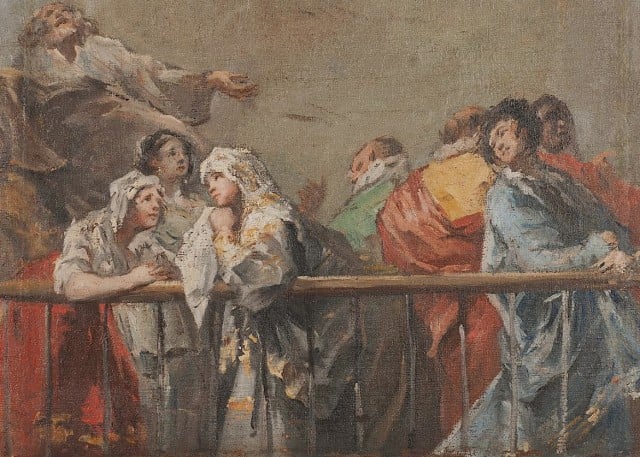
THE DAILY PIC: It’s hard to believe that this gorgeous bit of painting by Francisco de Goya, held at the Carnegie Museum of Art since 1965, has only been on view now and then. But that’s because it hasn’t always been acknowledged as the Spaniard’s work. This is about to change, as new research just about proves that the Pittsburgh painting is by him.
The prestigious Burlington Magazine is getting ready to publish an article, by the late art historian John Williams, that shows that Goya used the Carnegie piece to help him paint his great fresco around the base of the dome at the chapel of San Antonio de la Florida in Madrid, where he finished working in 1798.
What I’m showing as today’s Daily Pic is only a small detail of the narrow Pittsburgh canvas, two feet by nine, that comes very close to what’s on the walls at La Florida, spelling out a miracle from the life of Saint Anthony of Padua. (See the complete canvas reproduced below; click on either of my images to zoom in.)
As Williams argues, all the art historians who, over the decades, have dismissed the canvas as a copy of the fresco never actually saw it in the flesh, where its panache argues for Goya’s hand. “The quality and the manner are Goya’s,” said Carnegie curator Louise Lippincott, as she showed me the canvas last week.
In fact, the Carnegie piece has just the kind of deviations from the mural that you wouldn’t expect in a copy, but that would be normal if Goya used this canvas as a final study (or “modello”, in art-history speak) that he then worked up and enlarged on the church dome, making changes as he went.
That’s the story Lippincott tells, in an appendix to Williams’s article. Five nail holes that convervators found along the top edge of the canvas suggest that Goya could have stuck his modello onto a board, or even the wall, to be consulted as he moved around the perimeter of the dome, painting as he went. (It was only stretched as a finished work afterward; a copy would have been painted on canvas that was already on its stretcher.) It looks as though Goya used the Carnegie painting to finalize the fresco’s brilliantly tight composition, then kept it close at hand on his scaffolding. Working with his nose up against the wall, it’s hard to imagine how else he could have achieved his amazingly coherent results.
Today, one of the glories of the La Florida fresco is how disoriented it makes you feel as you crane your neck to see it, spinning around in the tight space of the little church – as though the dizziness of Los Caprichos, Goya’s wildest etchings, has passed into this sacred painting that he was working on at the same time.
At the Carnegie, Goya lovers can now see how he achieved that flux, laid out fair and square in front of them.
For a full survey of past Daily Pics visit blakegopnik.com/archive.